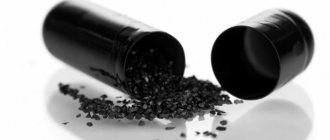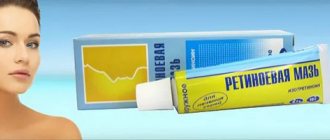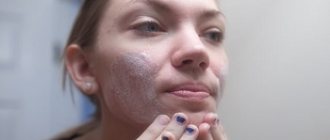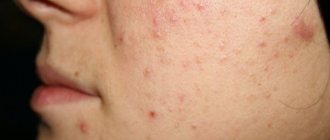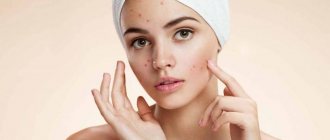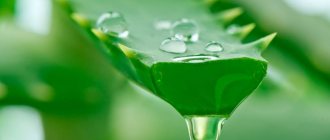Instructions for use of the drug
The medication is intended exclusively for external use. Before the procedure, you need to shake the bottle well to restore the suspension.
The medicinal composition is applied in a thin layer to the affected areas of the skin. For this purpose, it is best to use a cotton pad or cotton swab; in extreme cases, a gauze bandage may also be suitable.
Important information: Antibiotics for psoriasis: how to take antibacterial drugs?
The product should not be washed off after application; it should dry naturally. After it has dried naturally and after the applied product has exerted its therapeutic effect, the drug can be washed off with warm water. It is recommended to carry out procedures 3-6 times a day. A more precise regimen for using the drug is determined by the attending dermatologist.
Tsindol can be used in the treatment of psoriatic manifestations that occur on the skin of the facial part of the head.
Use of medication in the treatment of psoriasis in children, pregnant and lactating women
The ethyl alcohol contained in the drug can cause irritation of the child’s delicate skin, so most pediatricians recommend making your own ointment to treat the child’s skin.
Before preparing the ointment, you need to open the bottle for several days, during which time all the alcohol in the product will evaporate. The resulting sediment is mixed with baby cream. The finished product is used to treat the skin of a child; such procedures provide a good therapeutic effect during medical procedures.
In a woman’s body during pregnancy and lactation, against the background of hormonal changes, an exacerbation of skin diseases occurs. This period of a woman’s life is characterized by the fact that for therapeutic purposes the use of most drugs intended for the treatment of skin pathologies, including lichen planus, is prohibited.
The active components of the medicine are not absorbed into the bloodstream, which makes the medicine absolutely safe for the developing fetus. In some cases, even treatment of open wounds on the skin is allowed.
These properties of the drug allow it to be prescribed during pregnancy and breastfeeding without fear of negative effects on the unborn child.
Lactating women are recommended to use the drug on the skin of their nipples in the form of an ointment, which can be easily prepared independently.
Composition, release form, price
The main active ingredient of the drug is zinc oxide. It is an inorganic substance that is toxic to most skin bacteria. Zinc is not dangerous for humans if it is used strictly according to the instructions, only externally. Ethyl alcohol is used as a solvent - zinc oxide does not dissolve in water. In addition, alcohol has an additional antimicrobial effect, relieves acne pain, and reduces the activity of the inflammatory process.
Glycerin has a softening effect, acts as an additional solvent and gives the drug the desired thickness. It also helps the drug to be distributed evenly over the surface. Talc, starch and water complement the effect - they bring the consistency of the medicine to the desired properties.
Dosage form – suspension, i.e. a thick liquid interspersed with undissolved substances. Available in bottles that need to be shaken before use.
Use for children and pregnant women
Tsindol for children
The suspension is applied to the affected areas of the skin, which have previously been well washed and dried. The composition is left for several hours, after which it is washed off with plain water, and baby cream can be applied to the skin. After treatment with Tsindol, the burn wound is covered with a sterile gauze bandage. Treatment of wounds and scratches is carried out by simply applying a thin layer of suspension to the damaged skin. Tsindol copes well with allergic rashes, irritation and pimples on the child’s skin, which simply need to be regularly treated with the composition several times a day until the normal condition of the skin is restored.
Contraindications and unwanted actions
You need to know not only whether Tsindol helps with acne on the face and other parts of the body, but also whether the drug can be used at all.
Zinc oxide is slightly toxic to humans. The medication should not be used only if its medicinal and indifferent components are intolerant; in this case, it can cause allergies, manifested by hyperemia, itching and rash.
The suspension can be used for acne in women during pregnancy and lactation. The medicine has no age restrictions and is approved from the first days of life.
What is cindol?
At the pharmacy, Tsindol is sold in an inconspicuous bottle of 100 or 125 ml.
It does not have a catchy label, it is not displayed in the window or advertised on TV. Pharmacists advise customers on more expensive and popular drugs.
The product is popularly called talker.
Compound
Tsindol is a universal antiseptic that relieves inflammation.
- It contains distilled water and zinc, which is known for its drying properties.
- For example, zinc ointment and Desitin also work well against acne. The substance is part of the famous Zinerit solution.
- Ethyl alcohol 70% disinfects the surface of the epithelium.
- Glycerin, medical talc and starch provide the viscosity of the suspension and promote its deep penetration into the epidermis to the sites of infection.
Many people know that vitamin A or retinol and zinc are very important for treating acne. We are not talking about that common metal, the sheets of which even cover roofs. The body needs zinc in a biologically digestible form - in the form of an ion in the composition of harmless organic substances.
One should not think that external use of ointments or other dosage forms with zinc oxide provides the skin with a trace element. If such a remark is found in reviews of cindol for acne, then it should be treated with humor. The effect of such drugs is based on the fact that zinc oxide does not dissolve and protects the skin from caustic biological fluids.
Under the protective film of cindol, damaged skin tissues heal faster. In this case, insoluble zinc oxide does not penetrate the dermis and bloodstream.
"Tsindol" is used to treat eczema, dermatitis, eczema, and herpes rashes. Used for diaper rash, bedsores, abrasions and cuts, for example, during shaving. The product is often called “chatterbox,” but according to the instructions for use for acne and reviews, cindol is a suspension. Be sure to shake the bottle of medicine before use.
- 12.5 g of active ingredient - zinc oxide.
Auxiliary ingredients:
- ethyl alcohol 70%;
- distilled water;
- medical talc;
- glycerol;
- starch.
Zinc oxide is also an active component of ointments - zinc, salicylic-zinc, Desitin. The settled Tsindol suspension can be used to obtain a homemade ointment for acne. It is necessary to drain the liquid and mix the thick white sediment with a good baby cream (1:1). The resulting ointment does not contain petroleum jelly, which is very important for caring for problem skin.
The cost savings are quite significant: 100 rubles for baby cream, 100 rubles for tindol itself = 200 rubles (on average). Branded cosmetics for problem skin that are equally effective would cost 400–1200 rubles.
Does Tsindol help with acne?
Tsindol is an antiseptic drug for topical use. Unlike antibiotics, it affects the habitat of bacteria, making it unsuitable for their life and reproduction. Antiseptics are less effective than antibiotics, but they have significantly fewer side effects and bacteria do not develop insensitivity to them.
How are bacteria involved in the pathogenesis of acne? They penetrate clogged sebaceous glands, small scratches and enlarged pores, causing inflammation - red pimples. Bacterial activity can be triggered by a decrease in local immunity (due to a cold, stress or hormonal changes), disruption of metabolic processes in the skin (thick secretion of the sebaceous glands) or neglect of personal hygiene rules (activation of bacteria). Tsindol destroys excess bacterial activity, thereby not only fighting acne, but also preventing the appearance of new ulcers.
How to wash cindol off your face
Tsindol is a medicinal product containing zinc oxide.
It has two pronounced properties - anti-inflammatory and drying, especially useful in the treatment of acne .
Due to its ability to soften irritated skin, it is often used for eczema, all kinds of dermatitis, diaper rash, bedsores, traumatic skin damage and many inflammatory diseases.
What does it consist of and how is it produced?
The only form of release is a suspension, popularly referred to simply as a chatterbox. This means that Tsindol suspension and Tsindol mash are one and the same product. But cindol ointment is not sold anywhere, but it can be easily made at home. In addition, zindol anti-acne ointment helps as well as the drug itself from the pharmacy.
The purchased bottle just needs to be placed on a shelf at room temperature for three days. After this, sediment will appear at the bottom of the bubble. Then the water that remains on top just needs to be drained. The sediment is the same ointment.
If the resulting sediment cannot be applied to the affected area in an even layer, then you can add regular baby cream to it in equal proportions to the sediment. But it is not recommended to do so, just as you should not try to make something else out of a chatterbox.
The composition of the drug is quite simple. The active substance in it is zinc oxide and some additional components - talc, glycerin, distilled water, starch. The medicine is produced only in bottles with a volume of 125 ml. The bottles themselves are made of dark glass.
We can say that zindol and zinc ointment are the same medicine. And if the first drug is liquid, then zinc ointment is available in tubes and is a little easier to use.
At the same time, there is no other variety - cindol cream. This medicine, which can be seen in the photo, is sold in pharmacies only in one form - in the form of a suspension.
How does the medicine work?
The pharmaceutical liquid remedy Tsindol is one of the best for acne , and you can use it at any age. According to the instructions , the drug has several actions at once:
- Anti-inflammatory.
- Drying.
- Adsorbent.
- Astringent.
- Antiseptic.
All this is explained by the zinc oxide contained in the mash, which is why the use of zindol is so diverse. Why is zinc oxide so unique?
The instructions for use contain information that this substance is very similar to human skin tissue. When applied, it forms albumin protein salts, which help actively fight inflammation. Thanks to its other action - denaturation, the medicine significantly reduces fluid secretion, reduces inflammation and irritation.
A layer of such proteins forms a protective layer on the surface of the human body that prevents re-infection, and it becomes a real layer of protection, under which the healing process takes place.
If apply cindol to inflamed skin, you can get rid of even the most severe acne in the shortest possible time. And this is despite the fact that the price of the drug is much lower than the cost of most advertised cosmetics, which are also recommended for use in the treatment of acne.
When to use
What does cindol help with ? The main indications for use are pimples, blackheads, acne, acne, comedones and many other inflammatory diseases that appear on the skin. These include:
- Diaper rash.
- Prickly heat.
- Diaper dermatitis.
- Contact dermatitis.
- Allergic dermatitis.
- Bedsores.
- Wounds.
- Scratches.
- Cuts.
- Sunburns.
- Burns from boiling water.
- Trophic ulcers.
- Eczema.
- Herpes rash.
- Streptoderma.
However, before you start using the suspension , you must consult a specialist.
Contraindications
In addition to indications for use , there are also contraindications, but there are not as many of them as one might expect. First of all, this is an allergic reaction or intolerance to one of the components that make up the mash. The use of zindol ointment , if you need exactly this form, will have the same indications and contraindications.
Instructions for using cindol for acne
Using Tsindol for acne is very simple. Many people ask, is it possible to smear it on the face ? There is nothing wrong with this method of application, because acne appears on this part of the body.
How to apply correctly ? The first thing to do is wash with warm water and dry well. To ensure complete drying after washing, it is better to wait at least 15 minutes.
The bottle of cindol suspension must be shaken thoroughly before use. After this, apply the liquid to the inflamed areas of the skin in any convenient way.
If there are only a few pimples on the skin, then it is more convenient to do this with a cotton swab.
If necessary, apply to the entire face, you can take a cotton pad. After application, the “mask” is left on the face for a couple of hours, after which it is washed off.
How is it recommended to wash off cindol? It is advisable to do this with warm running water. This treatment should be carried out 4 to 6 times a day. The full course of treatment will last from 2-3 to 30 days.
There is another simple method of use, which is described in the instructions for use of the cindol suspension .
The medicine is applied to the skin in the evening, before bedtime and washed off only in the morning. But it is better to avoid this method of treatment for those who have dry skin, in which case severe peeling will begin. Tsindol for acne can be applied not only to the face, but also to the back, décolleté, shoulders and other areas of the body where acne appears.
Acne is unpleasant, but not at all fatal. Today there are many medications that can help you:
Source: https://ophthalmologys.ru/chem-smyt-cindol-s-lica/
Use of Tsindol for chickenpox
For chickenpox, it is permissible to use Tsindol in combination with brilliant green or instead of it. The product effectively fights blisters on the skin and prevents bacterial infections. Unlike brilliant green, it has no color, therefore, the patient will not experience discomfort, embarrassment, typical for the treatment of chickenpox.
It should be remembered that the disease is very contagious, so the patient should be quarantined. Currently, the percentage of schoolchildren and adults who did not have chickenpox in childhood is increasing, so even an adult patient can pose an epidemic danger to other adults.
Thus, cindol not only fights acne, but also solves a variety of skin problems:
Therapeutic effects for psoriasis
The use of the drug during the treatment of psoriasis has a complex effect on the patient’s body due to the main active compounds included in its composition.
Important information: Thai ointments and creams for psoriasis
Zinc oxide, when it comes into contact with skin damaged by psoriatic changes, leads to denaturation of protein compounds. Due to the denaturation process, a protective film is formed on the surface. The formed protective film of denatured protein compounds protects the affected area from the penetration of contaminants and exposure to aggressive allergic substances. At the same time, zinc oxide leads to a decrease in the amount of exudate produced and the intensity of the inflammatory process decreases.
Medical talc ensures the absorption of moisture and other chemical compounds on the surface of damaged skin. As a result of these processes, the nerve endings of the skin are not damaged when exposed to external stimuli. Under the influence of talc, a mechanical barrier is created that prevents the occurrence of microdamage.
Glycerin helps moisturize the skin and softens the top layer of skin epidermal cells. Additionally, glycerin can have a detrimental effect on a large number of representatives of pathogenic flora.
The combination of all of these properties ensures that the drug has the following effects on the patient’s skin:
- astringent;
- adsorbent;
- anti-inflammatory;
- moisturizing.
In addition, this composition has a pronounced antiseptic property.
Therapeutic properties of zindol
Zinc oxide applied to damaged skin causes anti-inflammatory, astringent and antiseptic effects. The therapeutic effect of the drug depends on the properties of zinc oxide and, in part, on the auxiliary components, especially ethyl alcohol. Tsindol significantly reduces the intensity of pathological phenomena in the skin, exhibits a protective and softening effect. Due to these properties, the drug Tsindol is classified as a dermatotropic agent.
When using zindol, the wound surface dries out, swelling and redness decrease, and the activity of pathogenic microflora decreases.
Protective role
Protein substances play a significant role in irritation and inflammation during acne, dermatitis and other skin lesions. When zindol is applied externally, denaturation of albumin proteins occurs and albuminates are formed, creating a protective barrier on damaged skin. The amount of fluid released decreases, the skin dries out - these factors play a leading role in the inflammatory process.
Softening effect
Irritation of the epithelium occurs due to the action of other negative factors. The use of the suspension allows you to soften the skin, protect it from excessive peeling and dryness.

